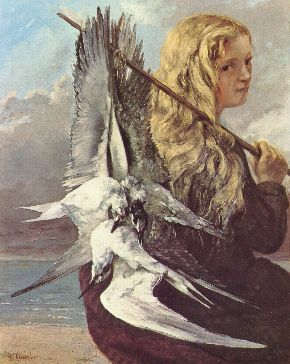Eyes as Symbols of Emotions and much more
I've been searching for a painter who exploited the expressive potential of eyes to their fullest and I've found him in Gustave Courbet (1819-1877), the French artist @pwadey tweeted about yesterday. Of course we met Courbet a little while ago when I was talking about hands.
The Hero Image is titled A Desperate Man and is one of Courbet’s many self portraits. Take another look at the image and note how the artist has used the wide expressive eyes to convey the emotion of desperation. The whites of the eyes contrast dramatically against the skin colour: the straight brows acting as a frame. In reality, Courbet looked like this photo below and you can note that he does have expressive eyes that challenge, inquire, defy. He was well aware of the importance and creative potential contained in eyes.

The photo above was taken by Gaspard-Félix Tournachon (1820 – 1910), known by the pseudonym Nadar, who was a French photographer, caricaturist, journalist, novelist, and balloonist (or, more accurately, proponent of manned flight). (Wikipedia) In another photo (below) note the discerning look in Courbet’s eyes- perhaps summing up the potential in a studio model.

As an artist there is so much to consider with respect to eyes. The first decision is- will you paint the eyes open or shut? Which way will best enhance the mood of the painting; the main emotion being represented? Extreme desperation is achieved with wide open eyes as we saw in the Hero Image, but what of other emotions? Look at this painting by Courbet.

Total relaxation is achieved with half closed eyes. Active or reformed smokers will know well the feeling expressed above in The Man with a Pipe - another self portrait by Courbet. Notice the angle of the bows, gently curving downwards in harmony with his eyelids. There is no desperation or conflict going on in this face; all features are enjoying the extreme pleasure of the moment.
But what of this man who has his eyes closed? Without the rest of the composition you could easily be lead to believe he is as relaxed as the man with the pipe.

But not so, this man is possibly dying as he is injured as hinted at by the small dash of blood on his chest and more obviously by the title: The Wounded Man. Half closed eyes (as in The Man with a Pipe) imply that the subject still has some control (good or bad) over his body. Closed eyes imply that control is being lost either through sleep or pending unconsciousness and possibly death.
Gustave Courbet was a controversial French painter, who bridged the gap between Romanticism and the Impressionist school of painters. He was controversial not only because he addressed social issues with his work, such as peasants and the working condition of the poor, and the rural bourgeoisie, but also because of the unsentimental way in which he portrayed them. Unlike the Romantic school of painters, Courbet did not use smooth lines and soft forms. Instead, he employed spontaneous brush strokes and a roughness of paint texture, which indicated that he was observing his subject directly from life, and thus challenging the academic ideas of the way art should be painted. Because of his development of a realistic form of painting, Courbet was a celebrity, and considered a genius, socialist, and savage. He also encouraged the perception of himself as an unschooled peasant. (Wikiart.org)

But I will leave you today with this beautiful painting of Jo, The Beautiful Irish Woman. It is sensuous and some of this feeling has been evoked by Courbet through her eyes and of course the glorious long wavy hair. Jo's eyes are quite exquisite as they gaze lovingly at her own image. Certainly somewhat narcissistic but let's concentrate on the expert craftsman's skill with the brush.

